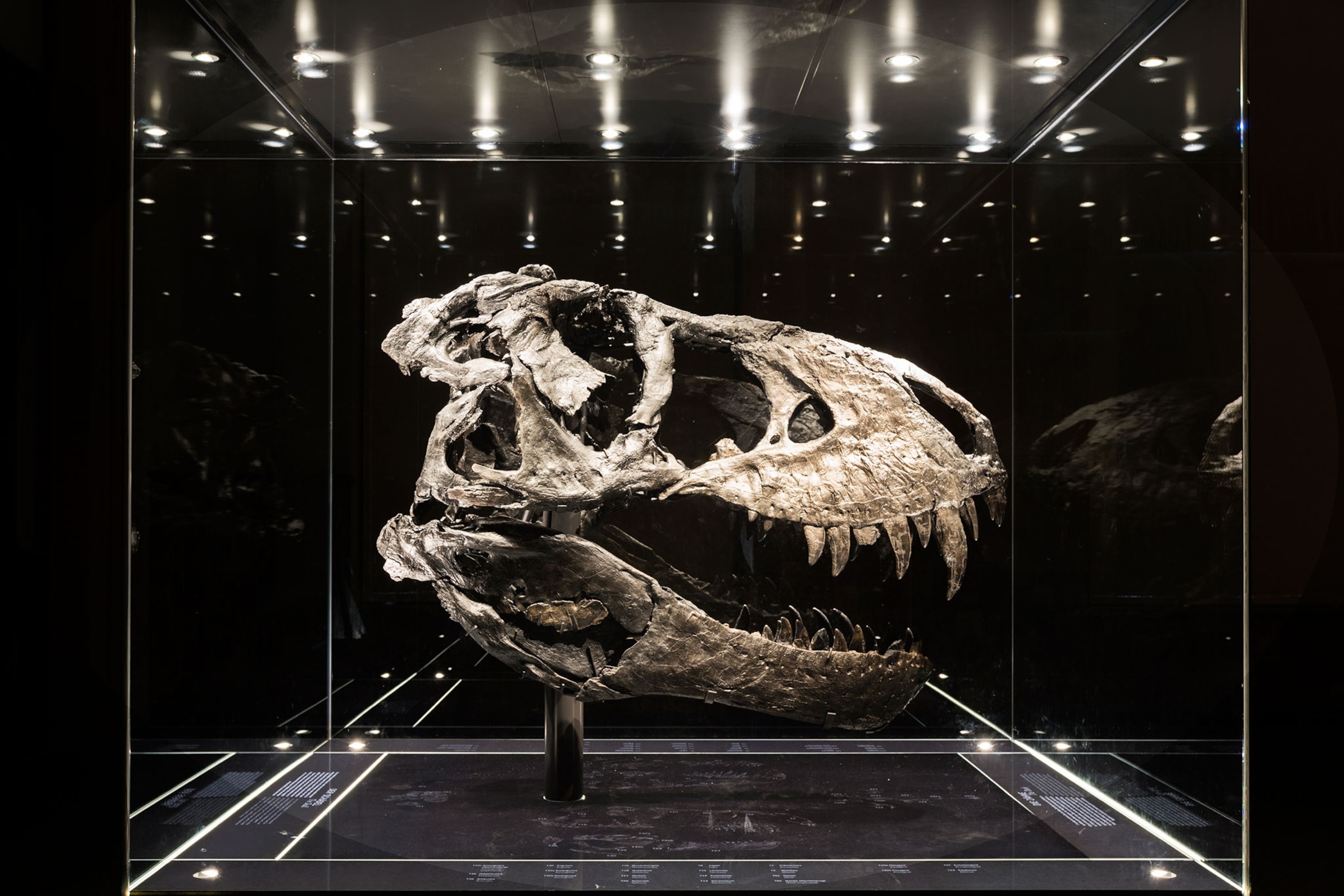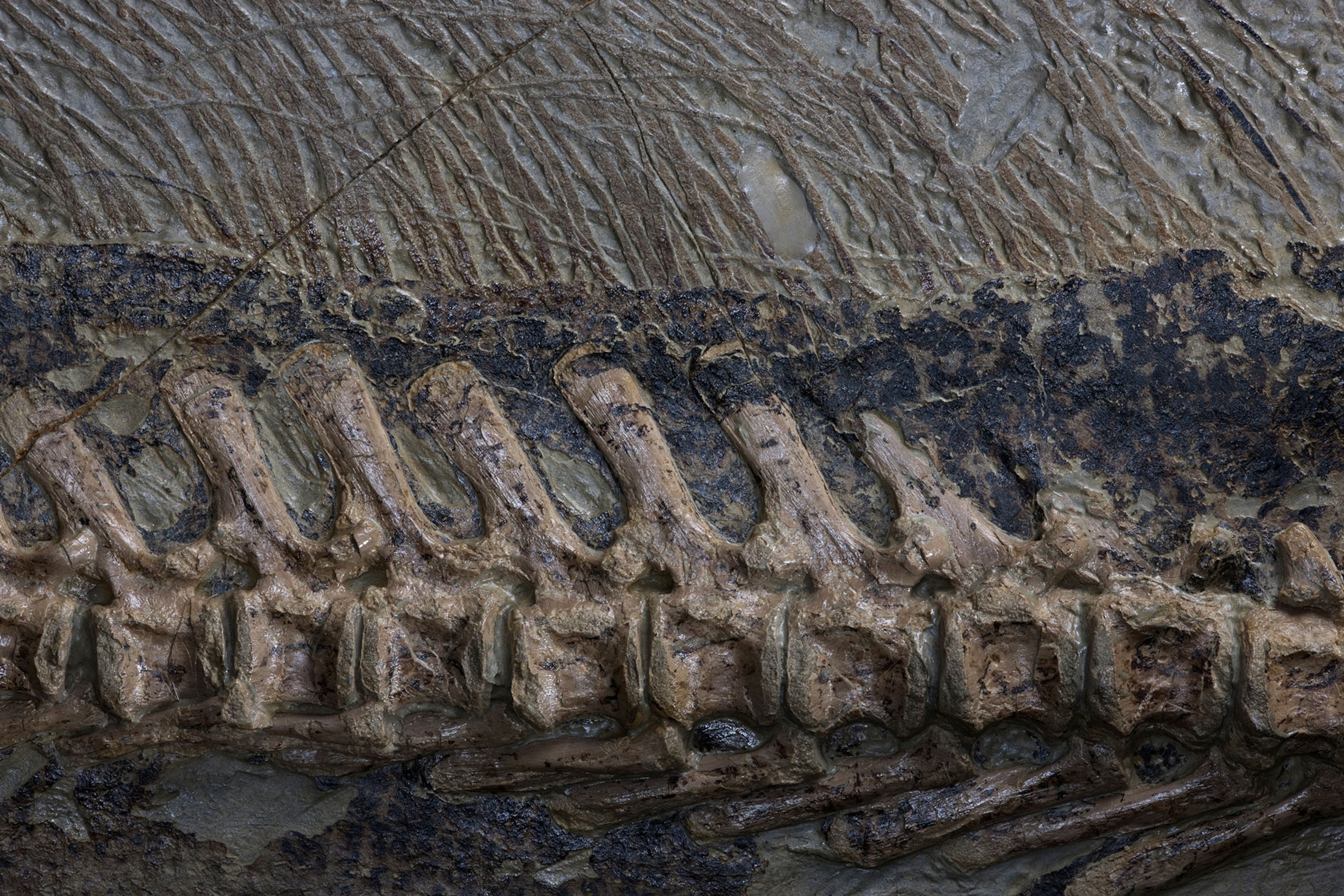If you could time-travel to Myanmar 99 million years ago, you’d see forests aflutter with toothed cousins of modern birds called the enantiornithines. From the corner of your eye, one of these ancient fliers might resemble a modern sparrow—except for its bizarrely long toes, an adaptation never before seen in any bird, living or dead.
The newly described bird, Elektorornis chenguangi, was found entombed within less than six grams of amber, scientists report today in the journal Current Biology. The lump of fossilized tree resin preserves part of the bird’s right hindlimb, as the sap evidently oozed onto the carcass. Though there are clear signs of decay—skin, frozen in time, is sloughing off the bone—the fossil also preserves the structure of the bird’s foot, including its extraordinarily long middle toes.
If human hands had similar proportions to Elektorornis’ feet, our middle fingers would be more than 60 percent longer than our index fingers—proportions that are so bizarre, their function currently mystifies scientists.
“The most interesting thing is that it’s an ecology that does not exist anymore, despite the fact that we have between 9,000 and 18,000 species of birds today,” says co-lead study author Jingmai O’Connor, a paleontologist at China’s Institute of Vertebrate Paleontology and Paleoanthropology (IVPP).

What’s more, Elektorornis is the first genus of bird described from a fossil encased in amber. While other pieces of amber have been found containing bird remains, those previous fossils weren’t complete or clear enough to let scientists identify them at the genus level. Not so with Elektorornis, whose feet stand out from the pack enough to make its classification clear.
“This is very important for the study of amber,” Lida Xing, the study’s other lead author and a National Geographic Explorer and paleontologist at the China University of Geosciences, says in an email. He calls Elektorornis “a brand-new animal from a new medium.”
Putting out feelers
There is one intriguing clue as to why Elektorornis had such long toes: The amber-entombed foot preserves bits of the surrounding skin and feathers, including strands called scutellate scale filaments. Living birds have similar-looking structures that act a bit like whiskers, helping them sense flying insects or subtle changes in airflow during flight. Whatever it was doing with its toes, Elektorornis may well have been relying on its sense of touch.
For now, the best guess is that Elektorornis used its extraordinary toes to plumb tree bark for insects, like a tiny avian version of Madagascar’s aye-aye, a lemur that uses its elongated fingers to snatch grubs and other insect larvae.
“I know it’s a pretty simplistic attempt, but it’s all we’ve got, to be honest,” O’Connor says. “Given that so many feathers have tactile function, and that we have these weird, tactile, bristle-looking feathers all over the foot and this elongated toe, it makes sense they would have been used in combination for some kind of foraging very similar to an aye-aye.”
The interpretation is plausible, says Santiago Claramunt, the associate curator of ornithology at the Royal Ontario Museum in Toronto. Some living birds, such as the scythebills of South America and the wood hoopoes of sub-Saharan Africa, also pick at rotting wood in pursuit of insects, but they do so with their specialized beaks.
“These primitive birds had teeth, and their snouts were different and more lizard-like,” Claramunt says. “Probably, the option of evolving a very long, thin, and curved snout was not possible for those ancient birds, so this could be an ecological equivalent.”
Future fossil finds would help clarify how Elektorornis made a living. Claramunt, for one, would love to see the bird’s skull, tailbone, and sternum, which would help show how it ate and whether it could truly climb up the sides of a tree, rather than just perch on twigs and branches. But for the moment, he’s impressed with the foot alone. And O’Connor suggests there are even more strange amber finds in store.
“This particular ecology is not utilized by the current [bird] diversity, and that’s also going to be really interesting with all the other amber specimens we’ll soon be publishing on," she says. "At least the next two I’m thinking of are clearly extinct ecological niches."
Scientific minefield
The polished amber blob that contains Elektorornis is housed in the Hupoge Amber Museum, in Tengchong, China, which also holds a baby enantiornithine entombed in fossilized resin. The species name, chenguangi, honors Guang Chen, one of the museum’s curators.
According to Xing, Chen first learned of the fossil in 2014, when a miner showed him a strange animal foot. At first, the miner thought the long-toed appendage belonged to an ancient lizard, given its resemblance to the feet of local lizards. But when Chen saw that foot had only four toes, he contacted Xing.
“I was very surprised [by the fossil] at the time, which is undoubtedly the claw of a bird,” Xing says in an email.
The find is the latest eye-popping fossil to emerge from the Hukawng Valley, a region in northern Myanmar’s Kachin state that has hosted amber mines for at least the last 2,000 years. Some 99 million years ago, the region was home to coastal forests full of trees that oozed tree resin. This goop eventually hardened, preserving traces of the ecosystem’s many smaller-bodied residents. So far, paleontologists have reported the remnants of feathered dinosaurs, ancient birds, snakes, and invertebrates of all kinds—even the washed-up, spiraled shell of an extinct marine mollusk.
Related: See the mystery and beauty of fossils























In the last decade, fossil discoveries in Burmese amber have exploded, in no small part due to the work of Xing. His research—including his work on Elektorornis—is partially funded by the National Geographic Society.
But as study of Burmese amber has intensified, so has ethical scrutiny on the field. For decades, the Kachin ethnic minority has bitterly fought Myanmar’s military for independence, and the region’s mineral wealth—including its amber—reportedly has helped fund the conflict.
Technically, it is illegal for fossils to be exported from Myanmar without permission, but raw amber is classified as a gemstone, and so it regularly makes its way into markets in western China, where it is then cut, polished, and traded. Researchers, dealers, and collectors prowl the markets on the lookout for scientifically valuable finds, some spending hundreds of thousands of dollars a year in the pursuit. Some fossils wend their way to scientific institutions, but others go to private collections, and owners may or may not support research on their holdings.
The Hupoge Amber Museum sits somewhere in between. It’s owned by the Tengchong City Amber Association, a group that also owns two large amber stores, one in Myitkyina, the capital city of Myanmar’s Kachin state, and another in the western Chinese city of Tengchong. Xing adds that the curator, Chen, has some amber mines of his own, as well as a private museum for especially rare amber specimens.
Xing, for one, hopes that museums like Chen’s will help bring more private collections into the open. Other private museums, such as the Lingpoge Amber Museum in Shanghai, don’t have much of a public presence and welcome outside scientists on a by-invitation basis only. (Read more about private amber museums.)
“This is a long story, but in simple terms, I am committed to formalizing these large-scale ... personal collectors,” Xing says in an email. “This is a good opportunity.”
Related Topics
You May Also Like
Go Further
Animals
- This ‘saber-toothed’ salmon wasn’t quite what we thoughtThis ‘saber-toothed’ salmon wasn’t quite what we thought
- Why this rhino-zebra friendship makes perfect senseWhy this rhino-zebra friendship makes perfect sense
- When did bioluminescence evolve? It’s older than we thought.When did bioluminescence evolve? It’s older than we thought.
- Soy, skim … spider. Are any of these technically milk?Soy, skim … spider. Are any of these technically milk?
- This pristine piece of the Amazon shows nature’s resilienceThis pristine piece of the Amazon shows nature’s resilience
Environment
- This pristine piece of the Amazon shows nature’s resilienceThis pristine piece of the Amazon shows nature’s resilience
- Listen to 30 years of climate change transformed into haunting musicListen to 30 years of climate change transformed into haunting music
- This ancient society tried to stop El Niño—with child sacrificeThis ancient society tried to stop El Niño—with child sacrifice
- U.S. plans to clean its drinking water. What does that mean?U.S. plans to clean its drinking water. What does that mean?
History & Culture
- Meet the original members of the tortured poets departmentMeet the original members of the tortured poets department
- Séances at the White House? Why these first ladies turned to the occultSéances at the White House? Why these first ladies turned to the occult
- Gambling is everywhere now. When is that a problem?Gambling is everywhere now. When is that a problem?
- Beauty is pain—at least it was in 17th-century SpainBeauty is pain—at least it was in 17th-century Spain
- The real spies who inspired ‘The Ministry of Ungentlemanly Warfare’The real spies who inspired ‘The Ministry of Ungentlemanly Warfare’
Science
- Here's how astronomers found one of the rarest phenomenons in spaceHere's how astronomers found one of the rarest phenomenons in space
- Not an extrovert or introvert? There’s a word for that.Not an extrovert or introvert? There’s a word for that.
- NASA has a plan to clean up space junk—but is going green enough?NASA has a plan to clean up space junk—but is going green enough?
- Soy, skim … spider. Are any of these technically milk?Soy, skim … spider. Are any of these technically milk?
- Can aspirin help protect against colorectal cancers?Can aspirin help protect against colorectal cancers?
Travel
- What it's like to hike the Camino del Mayab in MexicoWhat it's like to hike the Camino del Mayab in Mexico
- Is this small English town Yorkshire's culinary capital?Is this small English town Yorkshire's culinary capital?
- This chef is taking Indian cuisine in a bold new directionThis chef is taking Indian cuisine in a bold new direction
- Follow in the footsteps of Robin Hood in Sherwood ForestFollow in the footsteps of Robin Hood in Sherwood Forest








